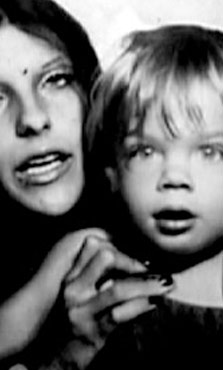 “Tarnation” begins with Jonathan Couette, the film’s star/subject, waking up on his couch as his lover David comes home. David kneels attentively by his side to stroke Jonathan’s hair, leaving the impression—along with Jonathan’s clumsy “Is it raining?”, which sounds like a recently run-over orphan’s “It’s so c-cold”—that Jonathan is suffering an illness much deeper than the fever he’s running. “I had a dream”, he manages to eke out. David, who’d make a good Red Cross nurse if they hired Armani models, gently lights the fuse. “What kind of dream?”, he asks his lover. Jonathan Couette, as we will shortly discover, is not a person who takes that question lightly. Game on. “Tarnation” begins with Jonathan Couette, the film’s star/subject, waking up on his couch as his lover David comes home. David kneels attentively by his side to stroke Jonathan’s hair, leaving the impression—along with Jonathan’s clumsy “Is it raining?”, which sounds like a recently run-over orphan’s “It’s so c-cold”—that Jonathan is suffering an illness much deeper than the fever he’s running. “I had a dream”, he manages to eke out. David, who’d make a good Red Cross nurse if they hired Armani models, gently lights the fuse. “What kind of dream?”, he asks his lover. Jonathan Couette, as we will shortly discover, is not a person who takes that question lightly. Game on.
Couette, who wrote this scene as part of a straightforward narrative to glue together his astonishingly rich collage of home movies, is putting in David’s mouth precisely the self-indulgence that makes “Tarnation” so immediately appealing. “What kind of dream?”: how often does anyone ask us a question like that (and mean it)? And how often do we have the dreams of our lives captured on video? Here is the visual record of a man who has asked himself that question all his life, an existence caught on video with an all access, eagle-eyed self-consciousness. Couette is a filmmaker and actor of moderate talents, but he knows a good scene when he’s about to live it. If anything keeps this out of the realm of sheer vanity, it’s that Couette has a clinical excuse for his self-consciousness. An early acid trip left him psychologically cleft in two, as if a detached observer in his own life. This condition gives the movies an added importance. These aren’t merely clips of a boy dancing in front of a lens, they’re about the person on the other side. Couette was studying himself like a detective looking for clues.
For a time the results are nothing less than enthralling. Couette’s mother’s story would fill two hours on its own, but combining it with his own journey—from Texas foster child, to the jolt of his sexual awakening, to life as a struggling actor in New York City—often produces magic. “Tarnation” hums with some of the explosive self-discovery of John Cameron Mitchell’s “Hedwig And The Angry Inch”—no surprise, as Mitchell helped get “Tarnation” off the ground—and Couette, even as a teenager, is certainly screenworthy. His production of David Lynch’s “Blue Velvet” as a musical for his no doubt puzzled classmates is the movie’s funniest sequence. Clips of Couette and some of his boyfriends are candid and unsentimental, and the quasi-goth, new wave style of the late Eighties is instantly familiar to anyone who lived through that decadent epoch.
The most affecting vein in the movie is Couette’s compassion for his mother, which yields a fine poignancy when he brings her to live with him in New York. Some of the bits along the way are uncomfortable; Couette sometimes leaves the camera running when it shouldn’t be, and often appears to be an invasive rather than benign observer of her madness. Mostly these mistakes serve the film, however, insofar as Couette finally comes across as reaching for answers he doesn’t have—studying her with the camera as scrupulously as he does himself.
But by indirectly and continually returning the focus to the man behind the camera, Couette ruptures the necessary wall between artist and man, fiction and documentary. The movie’s cake-and-eat-it-too duality gives us a fascinating life but denies any naive judgment of the film as a work of art. The tension in the memorable scene in which Couette, as a boy, does a rollicking imitation of an abused young wife who has murdered her husband, exists because Couette, you cannot help being aware, is watching himself. If he is the star of his own drama, he is also its director, writer, and editor, and this involves a degree of tampering. Even though Couette’s heart is clearly in the right place, his film finally becomes, in a word, stagey.
At the film’s conclusion, Jonathan walks into his den or living room to find his mother sleeping on the couch, much as he was at the beginning of the film. The caretaking circle is complete, and Jonathan touches her lips in an inexplicable link to an earlier story told by his grandfather about Wordsworthian innocence. But who observes this? Who holds the camera? Who has written this scene to create cohesion with the rest of the movie as a work of art? Redemption written is less interesting than redemption experienced. Giving his story a narrative arc subverts the touching anarchy of his lived experiences, leaving us with a final, disappointing sense that this—forgive me—schizophrenic film is neither the raw nor the cooked. |